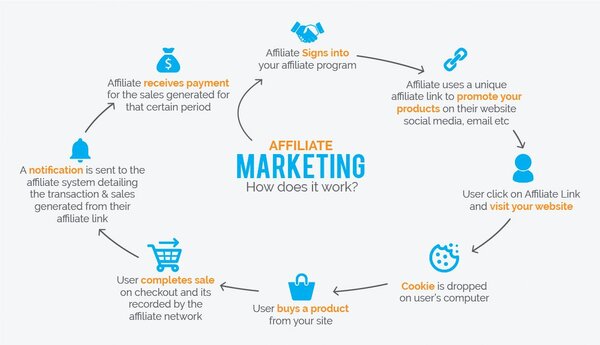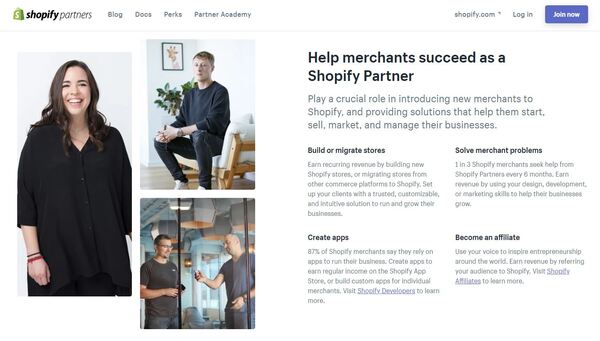Affiliate marketing is one of the best marketing methods quickly raising your brand’s awareness and rocketing online sales without any upfront cost.
The great thing is that starting with affiliate marketing is not difficult.
With myriads of affiliate marketing tutorials on the internet. It may be overwhelming for someone new to affiliate marketing.
No worries! We’ve got you covered.
This affiliate marketing for beginner merchants guide will be useful for businesses initially building up affiliate campaigns or looking for affiliate marketing tips to grow their business. By the end of this article, any merchants will surely know how to get started and thrive with affiliate marketing.
Ready? Let’s dive in!
Understanding affiliate marketing
Affiliate marketing is a performance-based marketing strategy motivating individuals (your affiliates) to promote your products/ service for commission exchange.
At the most basic, three parties involved are:
Merchants (also referred to as sellers, or brands, advertisers) are businesses selling products/services.
Affiliates (sometimes referred to as publishers) are those responsible for selling the merchant’s product/ service to their sizable audience.
Customers are consumers that fit within the affiliate’s target audience.
Here is how this work:
#1 You and affiliate collaborate either through a third party or directly
#2 The affiliate shares the product/service (typically through a referral link/ a coupon) to their audience
#3 The potential customer get engaged with the affiliate’s link
#4 The customer arrives at your landing page
#5 The consumer purchases your product
#6 The affiliate earns a commission
At the end of the day, you would get more and more customers and rocket sales with less effort.

Why leveraging affiliate marketing?
81% of businesses use affiliate marketing to catch customers’ attention, and raise revenue. Moreover, affiliate marketing is responsible for up to 16% of all eCommerce sales in the US.
And there is real-world proof that affiliate marketing works: Amazon generates 40% of its revenue via affiliate marketing through Amazon Associates and other third-party organizations selling their items.
Given its rising popularity, affiliate marketing is definitely worthwhile.
Here are some main reasons why merchants should not ignore affiliate marketing to rocket your revenue:
- Cost-effectiveness
With affiliate marketing, you’re not wasting money on places not showing their worth if you just pay commissions when the conversion occurs.
Moreover, without spending the expenditures of establishing a full-fledged marketing campaign, recruiting affiliates is a straightforward technique eliminating the need to invest money in an unproven industry for testing.
Aside from cost-effectiveness, lost cost corresponds to lower risk. As a result, affiliate marketing is also recommended for various business kinds, including small businesses on a budget.
- Targeted traffic
As you handpick your affiliates, you can ensure that the traffic coming to your site is from people who are interested in your product or service. This is because affiliates who connect with your brand will most likely have others in their circle of influence benefiting from it.
- Flexibility
Any industry can benefit from the affiliate marketing strategy whatever types of goods or services are.
No matter what niche you’re in, you’ll be able to locate a variety of affiliate programs once you get started in affiliate marketing.
Moreover, you can simply scale up or down your affiliate program at little or no expense. It also provides you with a cost-effective option to expand your organization.
- High ROI
Affiliate marketing is one of the greatest methods to get the highest return on investment.
Why? Since you are directing your marketing efforts through an affiliate that has direct access, influence, and responsiveness to a highly focused reception audience that is more inclined to purchase your company’s products.
To leverage affiliate marketing effectively, let’s move to the next part: Affiliate marketing for merchants step-by-step guide to build and run a successful campaign from start to finish.
Affiliate Marketing for Beginners: The Essentials
#1: Have qualified products
The first step to setting up a successful affiliate marketing campaign for merchants is to have qualified and high-quality products.
Not only can you provide the greatest and most dedicated products to your customers, but your affiliates can speak to the quality of your marketing efforts. Then, as a result of affiliates’ recommendations, their audience will be more likely to purchase a credible product.
#2: Make a blueprint for your affiliate marketing campaign
Affiliate marketing should never ignore a strong affiliate marketing campaign plan, which helps you have a clear path for merchants affiliate marketing success.
Building a suitable plan based on these things:
Determine your goals and objectives (How much profits you would like to generate? What types of customers do you want your program to bring in?)
Calculate finance (How much will you spend on total commissions for affiliates?)
Manage affiliates (What types of affiliates do you want to promote and sell products? How to track affiliates’ performance? How to maintain a good relationship with your affiliates?)
It’s probably hectic and confusing to manage your affiliate manually. With the help of UpPromote: Affiliate Marketing Software, an automated Shopify affiliate management app, you can easily manage affiliates and track their performance at your fingertips.
Starting from 0$/month, UpPromote is an ideal affiliate tool that every merchant needs!

#3: Create clear terms of service and privacy policy for affiliates
To avoid conflicts in affiliate marketing, merchants should create clear terms of service and privacy policy for affiliates to participate in the program, which clearly states the rights and obligations of each party.
The terms and conditions or operating agreements are commonly referred to as service terms and conditions. Initially, establishing guidelines and regulations can allow you to prevent misunderstandings and, worse yet, disagreements with affiliates.
You can refer samples to eventually make up one’s yours.
#4: Setup commission and payment system for affiliates
Merchants can pick from a variety of commission types for your affiliate marketing program, including:
Revenue Sharing Model: The affiliates receive a portion of sales made on their website.
Cost Per Action (CPA): The affiliate gets paid when a visitor completes a certain action. For example: Purchase a product via affiliate links.
Pay-per-click (PPC): The affiliates get paid based on the number of clicks they made to the merchant’s website.
Pay-per-acquisition (PPA): is a payment rate depending on a specific activity, such as when a new visitor subscribes to a newsletter or makes a purchase through an affiliate link.
Cost-per-lead (CPL): Affiliates get paid when a prospect provides their contact information.
Pay-per-impression (PPI): refers to a payment based on the number of times a website visitor views an advertisement.
Payments for affiliate commissions can be arranged in a variety of ways. When pre-determined goal levels are met, businesses can boost commission rates or offer bonuses to affiliate marketers.
PayPal, debit cards, gift cards, cheques, bank transfers are different options for payment.
Affiliate payments are often low and might be inconvenient to deal with monthly. Instead, look into mass payment alternatives that will handle these payments for you. It enables you to do simple marketing tasks without the hassle of making tiny payments regularly.
#5: Launch affiliate programs
It’s time for merchants to reach potential affiliates by launching your affiliate programs.
Before doing so, be sure you know how to target your prospects.
If you have the intention of approaching influencers within your niche, you have to understand their target audience and their content type to bring benefits for the stakeholders.
You can also push your program on your website or social media if you want to build a broader network.
Shopruthiegrace launched its affiliate program on Instagram, attracting many followers and users to apply for the program. To generate greater interest, they emphasize the advantages of being an affiliate and use the hashtag #affiliateprogram.

Otherwise, you can register your program with a network of affiliates such as ShareASale, CJ Partner, and other similar websites. This enables you to connect with potential affiliates worldwide to broaden your reach.
Or you can seek potential partners from affiliate solutions bringing together multiple media partners, such as UpPromote Marketplace (with 724000 affiliates onboard), which can help you speed up the affiliate recruiting process. The platform provides you with a list of trustworthy media partners.
Sale Dress has successfully expanded its affiliate network to 5000 affiliates onboard thanks to UpPromote Marketplace.
#6: Partner with the right affiliates
By investing wisely in the appropriate affiliates, 60% of major merchants achieved affiliate marketing profits of $5 million or more for merchants.
Building strong relationships with the appropriate affiliates is crucial to a successful affiliate marketing partnership. If your product isn’t a good fit for an affiliate’s audience, paying for access to their audience won’t help you much.
You should also look at how experienced the marketers you’re collaborating with are. The affiliate’s ability to promote your goods on their channels determines the effectiveness of an affiliate marketing strategy.
Choose Wheels is a website that offers detailed advice on personal transportation devices, with an emphasis on forming relationships with firms that sell them. They increased traffic by 124% in six months by focusing on the appropriate affiliates.

Before you find affiliate partners, ask yourself the following questions:
- Is this affiliate’s audience similar to my target audience? Will their target market provide them with high-quality leads?
- How long has this affiliate been in business? Is this affiliate responsive and eager to collaborate with you?
- What level of experience do they have with digital marketing principles such as blogging, email marketing, or SEO?
#7: Provide assistance for affiliate marketers
You are the one understanding your products/ services the most so that providing affiliates with the information, media materials they need can be beneficial to your program.
To understand more about your services/products, you can offer documents, datasheets, or other publications for affiliates. This will help you to offer your affiliates an accurate look at your brand.
You can choose to offer them access to marketing resources such as banners, logos, and official marketing materials so that they can best showcase your brand.
When we look at Shopify, which established a comprehensive independent affiliate network around their online store platform, we can see how they can get a lot more out of their affiliates by providing them with more resources and assistance.

Furthermore, maintain your affiliates on the open line of contact. You may accomplish this by regularly giving feedback on their performance or sending newsletters for updates on your services.
#8: Track affiliate program effectiveness
Gather specific data of your affiliate program such as affiliate performance, best-seller products, etc and then digging deeper into your affiliate program’s success and generate reports depending on the KPIs you’ve put up in the initial plan.
Here are a few examples of ways to assess the program’s success:
- What is your affiliate program’s conversion rate compared to other channels’ conversion rates?
- Is the AOV higher or lower now?
- What is the difference between spend and revenue return?
- Are you driving incremental sales with your program?
Having a clear knowledge of how incrementality is measured in your business will assist you in developing a process that generates precise statistics and actionable items to enhance this metric inside your affiliate program and throughout your overall strategy.
Best tips for affiliate marketing success
Leveraging affiliate marketing software
Doing affiliate marketing for merchants is overwhelming without the help of an affiliate marketing solution. So that leveraging affiliate marketing software to expand, track, and manage your affiliate marketing programs automatically can make things easier for you.
If you’re just getting started as a new merchant, complicated software will only confuse you and make your job more difficult. You don’t want your affiliate management system to be overly complicated.
After you’ve established your objectives and assessed your company’s requirements, you should focus on these key aspects to choose a suitable affiliate marketing software including:
- Cost-effective solution for your business
- The one provides prompt service and thorough onboarding/training so you can get the most out of your new system.
- Provide a platform for affiliate marketers to manage various affiliate initiatives.
- Internal capability for tracking affiliate performance
- Keep track of your affiliate commissions
Adapting all criteria above, UpPromote is a powerful Shopify affiliate marketing app that offers essential features of managing affiliate campaigns and affiliate tracking capabilities, helping users build affiliate campaigns from scratch then blossom their sales with affiliate marketing.
A significant Shopify store: Sale Dress has reached over $1 million in sales on affiliate marketing last year thanks to UpPromote. Now it’s your turn to grow with affiliate marketing.

Understand your affiliate partners
Understanding your affiliates is crucial not just for finding quality affiliates and selecting the appropriate ones; it’s also in your best interest if you want to build a dependable affiliate partnership offering you helpful feedback and insights to develop your program over time.
What does it mean to understand your affiliates?
- Getting to know their brand/ persona
- Determining what they enjoy
- Observing who they are following
- Seeing who is following them
- Exploring their social media presence, presentation, and tone
Get to know your affiliate partners. Know what you’re doing. Be of assistance. Establish a good working relationship. Demonstrate to your affiliates that you’re the genuine thing and that your affiliate program isn’t going to run itself!
Optimize your affiliate landing page
A landing page for affiliates created to attract potential publishers and influencers suitable for your program. An affiliate landing page drives your partners to action to sign up to advertise your products or services.
Some main elements of a successful affiliate landing page are:
Attractive headlines: Create headlines that highlight the many benefits of your program as well as the wants of your target audience. You can utilize A/B testing to determine which one is the most effective.
Include affiliate benefits: this determines the value of your commissions.
A clear call to action: It should be easy to spot. To lure your visitors to your CTA, employ design elements like buttons, colors, and white space.
Basic-focused page design: To convert more high-quality leads, it’s typically preferable to go with a simple and focused design.
Conclusion
With affiliate marketing for beginners guide, you probably acknowledge affiliate marketing basics, affiliate campaign setting up, and tips to succeed with affiliate marketing.
Hope you find this article helpful, all merchants can harvest success with affiliate marketing.
Good luck!
FAQs
How do affiliates promote merchants?
Affiliates promote merchants by creating content (such as blog posts, videos, or social media posts) that features the merchant’s products or services and includes an affiliate link. They may also use paid advertising or email marketing to drive traffic to the merchant’s website.
Why do affiliates promote merchants?
Affiliates promote merchants to earn a commission on sales made through their unique affiliate link or code. It’s a way for affiliates to generate income without having to create their own products or provide customer support, while also building relationships and credibility within their industry or niche.
What is referring to merchants as an affiliate?
Referring to merchants as an affiliate means that an individual or business is promoting the merchant’s products/services using an affiliate link or code, and earning a commission on any resulting sales. It’s a way for affiliates to generate income by promoting products or services that align with their niche or target audience.
What are the disadvantages of affiliate marketing for merchants?
The disadvantages of affiliate marketing for merchants include the need to pay commissions to affiliates, the potential for low-quality affiliates to damage their brand reputation, and the risk of fraudulent activity such as click fraud. Additionally, merchants may have limited control over the content and methods used by affiliates to promote their products or services.










